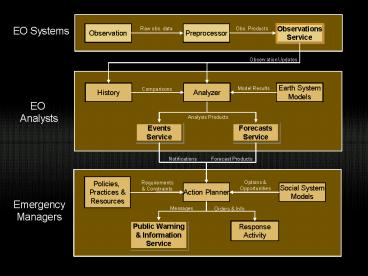Common Alerting Protocol CAP v. 1.0 - PowerPoint PPT Presentation
1 / 5
Title:
Common Alerting Protocol CAP v. 1.0
Description:
Need for President to articulate the vision of standards-based, all-media, all ... key people (non-federal governmental, non-governmental, commercial, academic) to ... – PowerPoint PPT presentation
Number of Views:77
Avg rating:3.0/5.0
Title: Common Alerting Protocol CAP v. 1.0
1
EO Systems
Obs. Products
Observation
Preprocessor
Observations Service
Raw obs. data
Observation Updates
History
Earth System Models
Analyzer
Model Results
Comparisons
EO Analysts
Analysis Products
Events Service
Forecasts Service
Forecast Products
Notifications
Policies, Practices Resources
Requirements Constraints
Options Opportunities
Social System Models
Action Planner
Emergency Managers
Messages
Orders Info
Public Warning Information Service
Response Activity
2
- Standards
- CAP (Common Alerting Protocol)
- FGDC (Federal Geospatial Data Committee)
- WMO and other domain-specific standards
- NIMS (National Incident Management System)
- OGC standards
3
- Constraints
- Need for timeliness from observation through
detection through warning - Uncertainty in observation, interpretation
- Conflicting observations
- Observational gaps (spatial, temporal and
thematic) - Connectivity Interoperability
- Ambiguous jurisdictions
- Inadequate models and history
4
- Issues
- Need for President to articulate the vision of
standards-based, all-media, all-hazards public
warning - Investment in iterative engagement with emergency
service system providers - Standardization
- Mutual education of users and providers
- Refinement and dissemination of models (earth
and social) - Integration of social science learnings with
emergency management practice
5
- Enablers
- Government funding for key people (non-federal
governmental, non-governmental, commercial,
academic) to engage with IEOS. - Energies of the open source community
- Focus of attention and urgency (public,
political) - Greater awareness of usability issues
- Maturing and convergence of technology and
provider community































